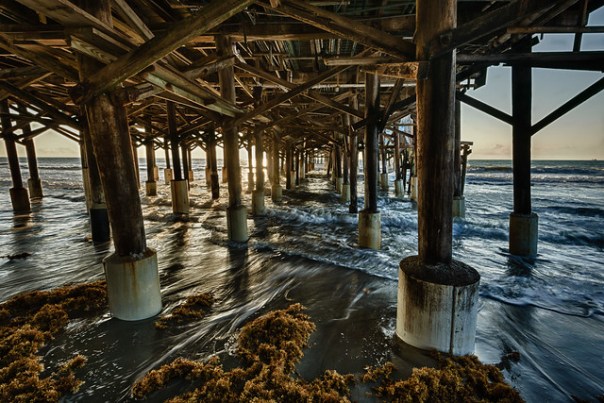One thing that’s really wonderful about the Merritt Island National Wildlife Refuge is that it’s such a large and varied area. Even if the main attractions (like Black Point Wildlife Drive) are slow, you can still find plenty to see and photograph in other areas. And the surroundings offer some very scenic Florida landscapes.
I visited once again Saturday morning with fellow Photography Interest Group member Kevin M. We stopped as we normally do at a likely spot on the way for a sunrise photo. This was the scene at Rotary Riverfront Park, just north of highway 50 on US 1. There’s a pier leading to a set of docks that offer many different compositions. It’s a beautiful place and although several people showed up to watch the sun rise, I was the first out on the pier – and felt a little bad when I disturbed a couple that had slept on one of the benches at the end.

Dawn in Titusville, Florida: There were several people enjoying the view from Rotary Riverfront Park, across from the Vehicle Assembly Building at NASA’s Kennedy Space Center (KSC). I tried my new Hoya ND400 neutral density filter and I like the way it works. If you haven’t used something similar, you should. It’s one way to make your photos stand out.
When we left and headed to Black Point, the clouds you see in the distance turned into rain, which fell off and on in spots for an hour or so. This made for “ISO 2000 light”, which means it was dim for good bird photography. It turns out that didn’t matter too much, since the birds were few and far between. We did see a few of the normal species: Anhingas, Belted Kingfishers, Cormorants, Great Blue and Little Blue Herons, Redish, Great and Snowy Egrets, Grebes, Moorhens, some unidentified ducks in the distance, and a few shore birds. The water there was very high – maybe the highest I’ve seen it. I wonder if this is related to the bird count or not?
After Black Point, we decided to try a new area and stopped by Hammock Trails. These take off in two directions from the parking area and wander through some hardwood trees as well as typical Florida pines and palms. We were hoping to see a few migrant Warblers, but had no luck. I’m not a very good birder – although I heard a few, I didn’t see a single one along these trails. I did come across this railroad track, which I thought made a good subject:

Leading to separation – Train tracks crossing Hammock Trail in Merritt Island National Wildlife Refuge. This is a Black & White conversion of a bracketed, Infra Red, Panorama
Our last stop of the day was the Visitor Center. Since our annual pass is expiring, we wanted to renew. We arrived at about 9:30. They don’t open until 10, so we wandered around for a bit.

Carolina Wren – Sighted along the boardwalk at the Merritt Island National Wildlife Refuge Visitor Center.
There wasn’t any activity at the bird feeder, but we could hear several birds on the boardwalk. We ended up seeing a Carolina Wren, a pair of Cardinals, a Black and White Warbler, and a Red Eyed Vireo, and I’m guessing there were others we didn’t see. The ranger mentioned White Eyed Vireos and we’ve seen them there in the past.
So we watched a nice sunrise, and even though the birds were scarce at a couple of areas, we ended up with some interesting avian sightings, and enjoyed being out. All in all, a very good morning.
If you click on the photos above, you’ll go to Flickr where you can view larger versions. You can see more MINWR photos in this set on Flickr, more sunrise photos in this set, and more Florida landscapes in this set.
Thanks for stopping by and reading my blog. Now – go make some photos!
©2012, Ed Rosack. All rights reserved






























